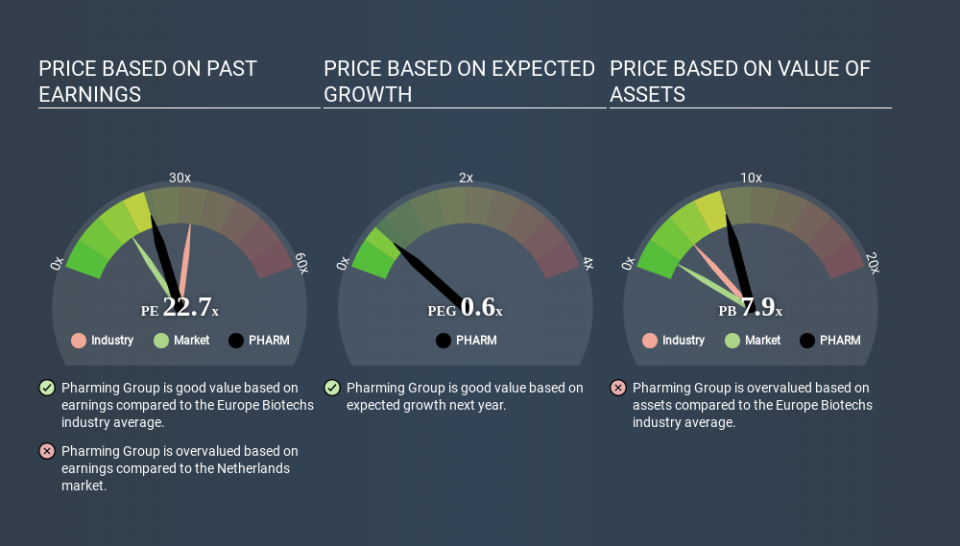A Rising Share Price Has Us Looking Closely At Pharming Group N.V.'s (AMS:PHARM) P/E Ratio

Pharming Group (AMS:PHARM) shareholders are no doubt pleased to see that the share price has bounced 30% in the last month alone, although it is still down 6.2% over the last quarter. That brought the twelve month gain to a very sharp 72%.
All else being equal, a sharp share price increase should make a stock less attractive to potential investors. While the market sentiment towards a stock is very changeable, in the long run, the share price will tend to move in the same direction as earnings per share. The implication here is that deep value investors might steer clear when expectations of a company are too high. One way to gauge market expectations of a stock is to look at its Price to Earnings Ratio (PE Ratio). A high P/E ratio means that investors have a high expectation about future growth, while a low P/E ratio means they have low expectations about future growth.
View our latest analysis for Pharming Group
How Does Pharming Group's P/E Ratio Compare To Its Peers?
We can tell from its P/E ratio of 22.68 that sentiment around Pharming Group isn't particularly high. We can see in the image below that the average P/E (33.1) for companies in the biotechs industry is higher than Pharming Group's P/E.
Its relatively low P/E ratio indicates that Pharming Group shareholders think it will struggle to do as well as other companies in its industry classification. While current expectations are low, the stock could be undervalued if the situation is better than the market assumes. It is arguably worth checking if insiders are buying shares, because that might imply they believe the stock is undervalued.
How Growth Rates Impact P/E Ratios
Probably the most important factor in determining what P/E a company trades on is the earnings growth. When earnings grow, the 'E' increases, over time. And in that case, the P/E ratio itself will drop rather quickly. A lower P/E should indicate the stock is cheap relative to others -- and that may attract buyers.
It's nice to see that Pharming Group grew EPS by a stonking 40% in the last year.
Remember: P/E Ratios Don't Consider The Balance Sheet
The 'Price' in P/E reflects the market capitalization of the company. Thus, the metric does not reflect cash or debt held by the company. In theory, a company can lower its future P/E ratio by using cash or debt to invest in growth.
Spending on growth might be good or bad a few years later, but the point is that the P/E ratio does not account for the option (or lack thereof).
How Does Pharming Group's Debt Impact Its P/E Ratio?
Pharming Group has net cash of €21m. That should lead to a higher P/E than if it did have debt, because its strong balance sheets gives it more options.
The Verdict On Pharming Group's P/E Ratio
Pharming Group has a P/E of 22.7. That's higher than the average in its market, which is 15.6. The excess cash it carries is the gravy on top its fast EPS growth. To us, this is the sort of company that we would expect to carry an above average price tag (relative to earnings). What is very clear is that the market has become significantly more optimistic about Pharming Group over the last month, with the P/E ratio rising from 17.4 back then to 22.7 today. For those who prefer to invest with the flow of momentum, that might mean it's time to put the stock on a watchlist, or research it. But the contrarian may see it as a missed opportunity.
Investors have an opportunity when market expectations about a stock are wrong. People often underestimate remarkable growth -- so investors can make money when fast growth is not fully appreciated. So this free visual report on analyst forecasts could hold the key to an excellent investment decision.
Of course, you might find a fantastic investment by looking at a few good candidates. So take a peek at this free list of companies with modest (or no) debt, trading on a P/E below 20.
If you spot an error that warrants correction, please contact the editor at editorial-team@simplywallst.com. This article by Simply Wall St is general in nature. It does not constitute a recommendation to buy or sell any stock, and does not take account of your objectives, or your financial situation. Simply Wall St has no position in the stocks mentioned.
We aim to bring you long-term focused research analysis driven by fundamental data. Note that our analysis may not factor in the latest price-sensitive company announcements or qualitative material. Thank you for reading.



